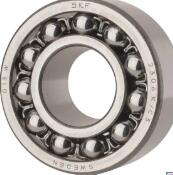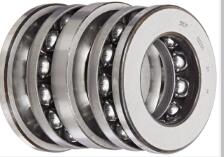Ball bearing vs thrust bearing, which is better?
This article compares ball bearing and thrust bearing to help you decide which is better for your application.
Learn about the pros and cons of each type of bearing to help you make the best decision.
When choosing the right type of bearing for a mechanical application, it can be hard to decide between a ball bearing and a thrust bearing.
Both have advantages and disadvantages, so it's necessary to understand the differences to make an informed decision about which is best for the job.
Ball bearings are better for high-speed applications and thrust bearings are better for heavier loads.
Ball bearings are more efficient, require less maintenance, and generate less heat than thrust bearings, yet, thrust bearings are more durable and can support higher loads. Ultimately, the best bearing depends on the application.
Both ball and thrust bearings have their advantages and disadvantages.
It is necessary to determine the purpose and usage of the bearing before deciding which one is better.
Definition
-
Ball bearing

A ball bearing is a type of bearing which uses balls to maintain the separation between the moving parts of the bearing.
The purpose of a ball bearing is to reduce rotational friction and support radial and axial loads.
It achieves this by using at least two races to contain the balls and transmit the loads through the balls.
-
Thrust bearing

A thrust bearing is a type of bearing used to reduce friction and wear between two moving surfaces, typically a shaft and a housing.
Thrust bearings are used in different applications, from industrial machinery to automotive parts.
They provide a low friction interface between the two components and reduce the amount of wear that would occur if they were in contact directly.
Comparison
-
Ball bearing
-
Components (balls, races, cage)
-
Ball bearings are a type of mechanical component that uses small metal balls to reduce friction between two parts.
Metal balls, races (sometimes referred to as the inner and outer rings), and the cage make up a ball bearing (also known as the retainer).
Metal balls are the most important component of a ball bearing.
They act as rollers between the inner and outer races, allowing the bearing to rotate smoothly and with minimal friction.
The balls are usually made from hardened steel, such as chrome steel, or a ceramic material such as zirconium oxide.
In some cases, balls may also be made from a combination of materials.
The races are two metal rings that fit around the metal balls.
The inner race is usually made from hardened steel, and the outer race is usually made from softer materials such as brass or bronze.
The races provide a smooth surface for the balls to roll against, which reduces friction and allows the bearing to rotate more efficiently.
The cage is the third component of a ball bearing. It is a metal or plastic ring that is used to keep the balls separated, and to ensure that they are evenly spaced.
-
Advantages (low friction, high speed, low noise)
Ball bearings are an essential part of many types of machinery and equipment, providing a variety of benefits. Ball bearings offer low friction, high speed, and low noise.
Low friction is a major advantage of ball bearings. Due to the smooth surfaces of the bearing components, ball bearings allow for smooth and efficient operation.
This means that the machinery or equipment will not require as much energy to operate, resulting in lower energy costs and less wear and tear on the components.
High speed is another advantage of ball bearings.
The low friction and smooth surfaces of the bearing components allow for the bearing to spin faster with less resistance, leading to a higher speed of operation.
This is especially beneficial in applications that require high-speed operation, such as motors, pumps, and turbines.
Low noise is also an advantage of ball bearings. The smooth surfaces and low friction of the bearing components reduce the amount of noise produced during operation.
This is beneficial in applications where noise is an issue, such as in medical equipment or industrial machinery.
Overall, ball bearings offer many advantages, including low friction, high speed, and low noise.
These advantages make ball bearings an ideal choice for a wide variety of machinery and equipment.
-
Disadvantages(limited load capacity, not suitable for high thrust loads)
Ball bearings have several disadvantages, most notably their limited load capacity and lack of suitability for high thrust loads.
Ball bearings are designed to carry radial loads, and are not suitable for applications that require high axial or thrust loads.
This is because the rolling elements in the bearing can not withstand large axial loads, and can be damaged if subjected to too much pressure.
-
Thrust bearing
-
Components (balls or rollers, races)
-
Balls or rollers are the rolling element of the bearing and are usually made of hardened steel.
Their purpose is to reduce friction and allow the bearing to carry heavy loads.
The balls or rollers are usually arranged in an alternating pattern between the races to provide increased surface area.
Races are the outer or inner surfaces of the bearing which the balls or rollers roll against. Races are usually made from hardened steel and are precision-ground for a smooth, low-friction surface.
These components work together to create a low-friction, high-load-bearing surface that is capable of handling the high loads associated with thrust applications.
-
Advantages (high load capacity for thrust loads, low friction)
Thrust bearings are an integral part of many machines and mechanisms in use today.
They are used to support axial loads and reduce friction.
The advantages of thrust bearings include high load capacity for thrust loads and low friction.
High load capacity for thrust loads. Thrust bearings are designed to handle large radial and axial loads, which makes them ideal for applications where high amounts of force are present or expected.
This makes them highly suitable for use in heavy machinery, such as presses and metalworking equipment.
Thrust bearings are designed to reduce friction and prevent metal-on-metal contact between moving parts.
This makes them ideal for use in high-speed applications such as engines and compressors.
-
Disadvantages (limited load capacity for radial loads, not suitable for high speeds)
Thrust bearings are used to support axial loads, but they are limited in their ability to support radial loads.
This means that they cannot be used for applications where radial loads are present.
Additionally, thrust bearings are not suitable for high speeds, as their design does not provide adequate support for high-speed applications.
This means that they are best suited for slow-speed applications.
Applications
-
Ball bearing
-
Fans
-
Ball bearings are widely used in the application of fans, such as ceiling fans and computer fans.
They help to reduce the friction caused by the fan blades and the shaft, allowing the fan to spin more smoothly and efficiently.
Ball bearings also help to reduce the amount of noise that is produced by the fan, making them a popular choice for many fan applications.
-
Motors
The application of ball bearings to motors is incredibly useful. Ball bearings can reduce the friction between two surfaces, allowing the motor to operate more efficiently and last longer.
They are also used to reduce noise and vibration, ensuring that the motor runs quietly and effectively.
Ball bearings are an essential component of any motor, and their application is essential for efficient operation.
-
Pulleys
Ball bearings are used in the application of pulleys to reduce friction and increase efficiency.
The ball bearings are arranged in an inner and outer race, with balls between them.
The balls rotate freely and reduce the friction between the two races, allowing the pulley to move smoothly and efficiently.
Ball bearings also provide support, which helps to reduce wear and tear on the pulley and its components.
This makes ball bearings ideal for use in pulley systems.
-
Sprockets
Ball bearings are used in sprockets to reduce friction and provide a smooth, efficient transfer of power from one sprocket to the next.
This makes it easier to change the speed and direction of the chain, providing better control and efficiency.
Ball bearings also have a longer lifespan than other types of bearings, making them a cost-effective option for applications where sprockets are used.
-
Thrust bearing
-
Aircraft engines
-
Thrust bearings are used in aircraft engines to support the shaft and absorb thrust loads from the engine.
This is especially important in applications such as turbojet engines, which generate high levels of thrust.
The thrust bearings help to reduce vibration and ensure the engine runs smoothly and efficiently.
They also help to reduce wear and tear on the engine components, improving their lifespan.
-
Automotive transmissions
Thrust bearings are an important component of automotive transmissions and are used to support the drive shafts and other components.
They are designed to handle high loads and help to keep the transmission system running smoothly.
They are typically made of hardened steel, which is strong and durable enough to handle the rigors of the transmission system.
A thrust bearing helps to reduce friction and wear on the transmission components and can help to extend the life of the transmission.
-
Machine tool spindles
Thrust bearings are used in machine tool spindles for a variety of reasons, including reducing friction between the spindle and the bearing surface, providing support to the spindle, and aiding in radial and axial alignment.
These bearings are designed to take the axial load applied to the spindle and provide a smooth, even force while spinning.
This ensures that the machine runs smoothly and accurately, and reduces wear and tear on the spindle itself.
-
Pumps
Thrust bearings are commonly used in pumps to absorb axial loads that are generated as a result of the high pressure and torque generated by the pump.
The thrust bearing acts as a support for the pump and helps to ensure that the pump shaft is kept in line and that the parts do not become excessively worn.
This helps to extend the life of the pump and ensures that it runs more efficiently.
Conclusion
In conclusion, the type of bearing that is best for a particular application is dependent on the design requirements, operating environment, and type of load.
Ball bearings are generally preferred for lighter loads and higher speeds, while thrust bearings are better for heavier loads and slower speeds.
Ultimately, the decision of which type of bearing is best for a particular application is a matter of careful consideration.





